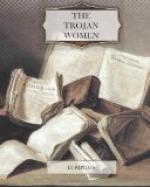[4] Laotian Tyndarid.]—Helen was the child of Zeus and Leda, and sister of Castor and Polydeuces; but her human father was Tyndareus, an old Spartan king. She is treated as “a prisoner and a prize,” i.e., as a captured enemy, not as a Greek princess delivered from the Trojans.
[5] In secret slain.]—Because the Greeks were ashamed of the bloody deed. See below, p. 42, and the scene on this subject in the Hecuba.
[6] Cassandra.]—In the Agamemnon the story is more clearly told, that Cassandra was loved by Apollo and endowed by him with the power of prophecy; then in some way she rejected or betrayed him, and he set upon her the curse that though seeing the truth she should never be believed. The figure of Cassandra in this play is not inconsistent with that version, but it makes a different impression. She is here a dedicated virgin, and her mystic love for Apollo does not seem to have suffered any breach.
[7] Pallas.]—(See above.) The historical explanation of the Trojan Pallas and the Greek Pallas is simple enough; but as soon as the two are mythologically personified and made one, there emerges just such a bitter and ruthless goddess as Euripides, in his revolt against the current mythology, loved to depict. But it is not only the mythology that he is attacking. He seems really to feel that if there are conscious gods ruling the world, they are cruel or “inhuman” beings.
[8]—Ajax the Less, son of Oileus, either ravished or attempted to ravish Cassandra (the story occurs in both forms) while she was clinging to the Palladium or image of Pallas. It is one of the great typical sins of the Sack of Troy, often depicted on vases.
[9] Faces of ships.]—Homeric ships had prows shaped and painted to look like birds’ or beasts’ heads. A ship was always a wonderfully live and vivid thing to the Greek poets. (Cf. p. 64.)
[10] Castor.]—Helen’s brother: the Eurotas, the river of her home, Sparta.
[11] Fifty seeds.]—Priam had fifty children, nineteen of them children of Hecuba (Il. vi. 451, &c.).
[12] Pirene.]—The celebrated spring on the hill of Corinth. Drawing water was a typical employment of slaves.
[13] ff., Theseus’ land, &c.]—Theseus’ land is Attica. The poet, in the midst of his bitterness over the present conduct of his city, clings the more to its old fame for humanity. The “land high-born” where the Peneues flows round the base of Mount Olympus in northern Thessaly is one of the haunts of Euripides’ dreams in many plays. Cf. Bacchae, 410 (p. 97 in my translation). Mount Aetna fronts the “Tyrians’ citadel,” i.e.., Carthage, built by the Phoenicians. The “sister land” is the district of Sybaris in South Italy, where the river Crathis has, or had, a red-gold colour, which makes golden the hair of men and the fleeces of sheep; and the water never lost its freshness.




